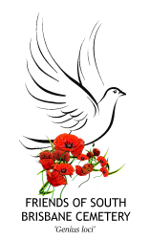Headstone Symbolism
When looking at headstones, it is usually the words and numbers of the inscriptions that first attract the attention, and so the variety of symbolism on those stones is often missed. At first glance much of it seems like nothing more than fancy peripheral decoration, but in reality the headstones are rich in religious and historical symbolism and provide an insight into the Victorian-era culture of death and remembrance. Middle-class families were expected to spend as much as they could afford on grave monuments appropriate to the social status of the deceased, and these monuments usually contained symbolic indicators of religion, professions, or mortality.
Many headstones and monuments are also superb works of public art, making the cemetery an open-air museum and testament to the immense skill of the local craftsmen who created them.

Some symbols found in the South Brisbane Cemetery
- Anchor: Early Christian symbol of hope; deceased had maritime connection.
- Angel: Messengers of God.
- Broken column: A life cut short.
- Clasped hands: Unity and affection even after death.
- Column: Universally associated with commemoration, and often used on war memorials.
- Flowers: Human life and beauty, but also have individual associations. Daisy: innocence. Lily: purity. Pansy: symbolizes remembrance and humility. Poppy: sleep. Rose: associated with the Virgin Mary. A red rose symbolizes martyrdom and a white rose symbolizes purity.
- Oak: Christ, whose cross was thought to be made from the oak.
- Palm: Originally a symbol of military victory, it was adapted into Christianity as a symbol of Christ’s victory of death.
- Hands: A hand with the index finger pointing upwards symbolizes the hope of heaven.
- Heart: Traditionally a symbol of love, courage and intelligence, the flaming heart signifies extreme ardor. The heart encircled with thorns symbolizes the suffering of Christ.
- Hourglass: The attribute of death and Father Time, the hourglass symbolises the passage of time and the shortness of life.
- Lamb: Christ in his sacrificial role; personifies innocence, gentleness and humility, and was often used on the graves of children.
- Obelisk: A 19th-century ‘Egyptian revival’ decoration universally associated with commemoration.
- Torch: Originally the torch was a Greek symbol of life and truth, but the inverted torch in funerary art symbolises death.
- Urn: Originating as a repository for the ashes of the dead in ancient times, the urn has evolved into a popular symbol of mourning.
- Wreath: Originally an ancient symbol of victory, it was adopted into the Christian religion to represent the victory of the Redemption. It is now a common memorial symbol.
Read more
The In Heavenly Garb: The Headstones of Ipswich General Cemetery book explores the hidden meanings behind the symbols on the historic headstones of the Ipswich General Cemetery, one of the city’s great open-air museums. You will be surprised by the decorative variety of the stones, the talent of the artisans who created them, and how the stones help tell the story of Ipswich itself. This is also an invaluable guide when visiting other historical cemeteries.


